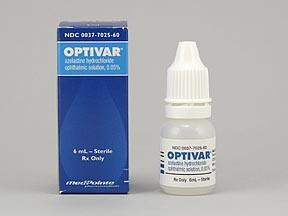Why is this medication prescribed?
Pink eye caused by allergies can be relieved with ophthlamic azelastine. The drug azelastine belongs to the antihistamine drug class. Histamine, a chemical in the body that causes allergy reactions, is blocked in order for it to function.
How should this medicine be used?
Ophthalmic azelastine is available as a liquid solution that is injected into the eye. Usually, it is injected into the afflicted eye(s) twice daily. Use azelastine at roughly the same time each day to aid in memory. Ask your doctor or pharmacist to explain any instructions on your prescription label that you are unsure about following. As directed, take azelastine. Use it only as directed by your doctor, neither more nor less often.
Follow these steps to administer the eye drops:
- Use soap and water to thoroughly wash your hands.
- Make sure the dropper tip is not cracked or chipped by inspecting it.
- Eye drops and droppers must be kept clean; avoid contacting the dropper tip to your eye or anything else.
- Pull your lower eyelid down to create a pocket with your index finger while cocking your head back.
- With your other hand, place the dropper as near to your eye as you can without touching it, tip down.
- Place the hand’s remaining fingers to your face.
- Squeeze the dropper gently while looking up so that a single drop falls into the lower eyelid’s pocket. Your index finger should be taken off the lower eyelid.
- Tip your head down so that you are looking at the floor while closing your eyes for two to three minutes. Avoid blinking or squeezing your eyelids.
- Give the tear duct a gentle squeeze with your finger.
- Use a tissue to remove any extra liquid from your face.
- Wait at least 5 minutes before administering the subsequent drop if you need to use more than one in the same eye.
- Replace and secure the dropper bottle’s cap. Never rinse or clean the dropper tip.
- To get rid of any medication, wash your hands.
Other uses for this medicine
Ask your doctor or pharmacist for more details if you believe this medication should be used for something else.
What special precautions should I follow?
Before using azelastine eye drops,
- If you have a reaction to azelastine or any other medication, tell your doctor and pharmacist right away.
- Inform your physician and pharmacist about all prescription and over-the-counter drugs, vitamins, dietary supplements, and herbal products you are taking.
- Inform your doctor if you are expecting, intend to get pregnant, or are nursing a baby. Call your doctor if you become pregnant while taking azelastine.
- If your eye(s) are red, you should be aware that you shouldn’t wear contact lenses. If you wear contact lenses and your eye is not red, you should be aware that azelastine solution contains benzalkonium chloride, which soft contact lenses can absorb. Before administering azelastine, take out your contact lenses, and then replace them after waiting 10 minutes.
What special dietary instructions should I follow?
Keep eating normally unless your doctor instructs you otherwise.
What should I do if I forget a dose?
The missed dose should be administered as soon as you remember. If the next dose is soon due, skip the missed one and carry on with your regular dosing plan. To make up for a missed dose, do not administer a second dose.
What side effects can this medication cause?
Side effects from azelastine are possible. If any of these symptoms are severe or do not go away, let your doctor know right once:
- Eyes hurting or burning
- Headaches
- Bitter flavour
- Eye discomfort
- Distorted vision
- Excessive fatigue
- Unwell throat
Some adverse effects can be very harmful. Call your doctor right away if you experience any of the following symptoms:
- Having trouble breathing
Other negative effects of azelastine may occur. If you experience any strange issues while taking this drug, call your doctor right away.
You or your doctor can submit a report to the Food and Drug Administration’s (FDA) MedWatch Adverse Event Reporting programme online or by phone if you experience a serious side effect.
What should I know about storage and disposal of this medication?
Keep this medication tightly closed in the original container and out of the reach of children. Store it away from excessive heat and moisture at room temperature.
Unused prescriptions must be disposed of carefully to prevent pets, kids, and other people from ingesting them. You should not, however, dispose of this medication in the toilet. Instead, utilising a medicine take-back programme is the easiest approach to get rid of your medication. To find out about take-back programmes in your area, speak with your pharmacist or the garbage/recycling department in your city. If you do not have access to a take-back programme, see the FDA’s Safe Disposal of Medicines website at http://goo.gl/c4Rm4p for additional information.
As many containers (such as weekly pill minders and those for eye drops, creams, patches, and inhalers) are not child-resistant and are simple for young children to open, it is crucial to keep all medications out of sight and out of reach of children. Always lock safety caps and promptly stash medication up and away from young children where it is out of their sight and reach to prevent poisoning. http://www.upandaway.org
What other information should I know?
Keep all of your doctor’s appointments.
Do not share your medication with anyone else. Any queries you may have regarding prescription refills should be directed to your pharmacist.
You should keep a written record of every medication you take, including any over-the-counter (OTC) items, prescription drugs, and dietary supplements like vitamins and minerals. This list should be brought with you whenever you see a doctor or are admitted to the hospital. You should always have this information with you in case of emergencies.
Brand names
- Optivar®


